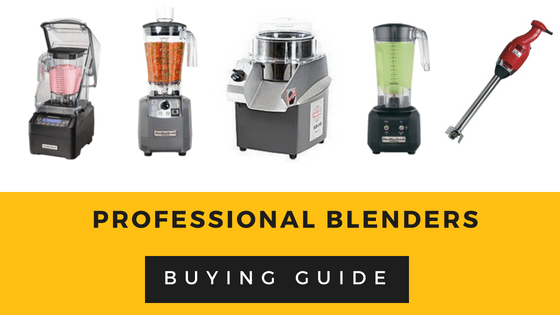The two things professional blenders offer are power and durability. However, it’s important to choose the right blender for its intended use. This Buying Guide will highlight the differences between domestic and professional blenders, and provide an overview of the types of professional blenders and the benefits of each.
Difference between professional and domestic blenders
As budget is a key factor for any business, it’s important to consider why a professional blender is a more suitable option than a domestic blender.
- Size of the bowl/jug, blades, and the blender – Professional blenders tend to have a bigger bowl/jug, larger, stronger and sharper blades, and overall be larger in size than domestic blenders.
- Speed and power of the motor – Most blenders have variable speed controls, but a big difference between professional and domestic blenders is the power of the motor. Domestic blenders that are only used occasionally for chopping and mixing tend to have relatively low power motors. In comparison, professional blenders have a more powerful motor that will not break down after extensive use.
- The power of the average domestic blender is around 175 watts.
- The power of a professional blender can be as high as 1,440 watts.
- Plastic, glass or stainless steel bowl/jug – Each type of bowl/jug has its advantages. Plastic is lightweight and provides visibility of contents. It can, however, absorb smells. Glass is heavier than plastic, provides visibility of contents, but may break. A big advantage of a glass bowl/jug is it won’t absorb odours. Stainless steel bowls/jugs are the strongest and most durable option. Like glass, stainless steel won’t absorb odours, but you can’t see through it.
- Quality – Given how often professional blenders are used, they must be extremely robust and are better quality than domestic blenders.
- Price – While a domestic blender is cheaper option, its strength, durability, and power will not match that of a professional blender. The power of a domestic blender’s motor will not withstand frequent and long-term use. If used in a commercial context, domestic blenders will need to be replaced more often than a professional blender.
Types of blenders for commercial use
For commercial environments, there are basically four types of blenders (excluding juicers):
Designed for frequent use, commercial food blenders can withstand continuous operation without the motor burning out. They are robust enough to break down hard food items such as ice, chocolate, almonds, and vegetables, while also blending smoothies to a beautiful consistency. While they may cost more, they are worth the investment if you are looking for a frequently used professional blender to sit on a countertop.
Mixer and Blenders process all consistences, both raw and cooked, and dry or liquid. Like food blenders, these are extremely versatile machines. Where they excel, however, is their stronger motor for frequent and high-volume use.
Ranging from lighter-duty models to high-volume units, bar blenders are perfect for placing on the bar for making cocktails. Bar blenders aren’t as robust as food blenders but are fine for making the occasional smoothie.
Bartenders and mixologists will appreciate the clear jugs and product visibility that come with bar blenders. If you’re looking to minimise noise, some Bar blenders come with a sound enclosure (or offered as an accessory).
Stick Mixers / Immersion Blenders
Available in a variety of lengths, speeds, and strength/power of the motor, stick blenders are an extremely versatile piece of equipment for the commercial kitchen. They are small, portable, manoeuvrable, easy to clean and take up minimal space. To use, simply insert the stick blender into the pot or bowl and blend or pulse. On the downside, you can’t multi-task while using. This is, however, one of the best types of blenders for commercial kitchens.
Considerations when buying
A good blender that suits your needs and budget is well worth the investment. To ensure you make the right decision, work through the following checklist of things to consider before you buy that blender:
- Purpose – Will you be making drinks, chopping vegetables, grinding nuts or coffee, or blending liquids and solids?
- The frequency of use – All day every day prior to each service, or occasionally when a customer wants a smoothie or cocktail.
- Volume and capacity – Single serve or bulk preparation will determine bowl/jug capacity, speed options and the power of the motor.
- Space and portability – Apart from stick blenders, you will need countertop or bench space to set up and use your blender. The availability of space will determine whether the blender is kept in one position or returned to storage after use. Stick blenders have a big advantage in that they don’t require a lot of space to use or store.
- Budget – In our unbiased opinion, we would recommend buying a blender that not only meets your needs but will serve those needs for the long term. This may mean paying more, initially, for a stronger motor and overall strength, durability and quality. The useful life of a good quality blender will be longer than a cheaper, domestic alternative that will need replacing sooner and more often.
Blender brands we recommend
- Hamilton Beach Blenders
- Hallde Vertical Cutter Blenders / Mixers
- Sammic Professional Stick Blenders / Immersion Blenders
- Thermomix
Service stars here
Members of our team have been working in the hospitality industry for more than 20 years. If you have any questions about blenders please let us know. We can help you choose the right option to suit your needs.
Please feel free to call us on (02) 9052 9111

